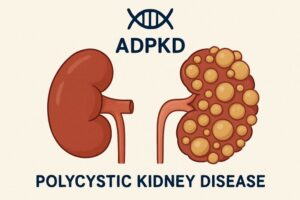Table of Contents
- Introduction
- Genetic Basis of ADPKD
- Common Symptoms and Diagnosis
- Complications Associated with ADPKD
- Management and Treatment Options
- Lifestyle Modifications for ADPKD Patients
- Recent Research and Advancements
- Support and Resources
Introduction
Autosomal Dominant Polycystic Kidney Disease (ADPKD) is one of the most common inherited kidney disorders, affecting thousands of families worldwide. This progressive genetic disease is characterized by the development of numerous cysts—fluid-filled sacs—within the kidneys, which can eventually impair their function. Early awareness and management can significantly affect individuals and their families. Those interested in new treatments and ongoing research should consider reviewing this actively recruiting clinical trial for polycystic kidney disease. Understanding ADPKD extends beyond genetics, encompassing symptoms, identifying complications, and applying up-to-date management strategies. Empowering yourself with accurate information ensures better health choices and engagement with healthcare professionals. Since ADPKD’s progression and symptoms often vary, personalized care remains crucial for optimal outcomes. With support resources and advocacy, many living with ADPKD can now access new information, participate in clinical trials, and navigate a growing body of research to extend and improve their quality of life. This article aims to bridge the information gap on causes, diagnosis, management, and support, helping patients and families actively participate in care decisions. Monitor your health, connect with specialists, and leverage available educational tools as a proactive approach to managing this complex disease.

Genetic Basis of ADPKD
ADPKD primarily results from mutations in either the PKD1 or PKD2 genes. These genes provide instructions for producing proteins that play critical roles in kidney function, and when mutated, they prompt the development of countless cysts. This autosomal dominant pattern means each child of a parent with ADPKD has a 50% chance of inheriting the mutated gene. Due to the variable nature of gene expression, symptoms and disease severity can widely differ—even within the same family. Cyst growth begins in childhood, but symptoms often do not appear until adulthood. The slow and unpredictable progression highlights the importance of family health history and genetic counseling for at-risk individuals. The National Institute of Diabetes and Digestive and Kidney Diseases offers comprehensive resources, such as the NIDDK ADPKD resource.
Common Symptoms and Diagnosis
Most cases of ADPKD remain silent until the cysts enlarge enough to disrupt normal kidney function. When symptoms occur, they often include:
- High blood pressure (hypertension)
- Pain in the back or sides
- Hematuria (blood in the urine)
- Recurrent urinary tract infections
- Kidney stones
Diagnosing ADPKD generally involves non-invasive imaging tests. An ultrasound is commonly the first step, as it can detect cysts. MRI or CT scans provide additional detail in some cases, especially when kidney size complicates the diagnosis. Genetic testing may confirm a diagnosis and help with family planning or early intervention strategies.
Complications Associated with ADPKD
ADPKD is a systemic disorder, meaning its impact can reach beyond the kidneys. Liver cysts are common in adult patients and may sometimes cause discomfort or complications. Intracranial aneurysms—bulging blood vessels in the brain—are a serious concern because their rupture can be life-threatening. Additional complications include heart valve abnormalities and diverticulosis in the colon.
Monitoring and Prevention
Regular medical follow-up is vital, particularly for detecting changes in blood pressure, kidney function, and signs of cyst-associated complications. Early intervention can prevent or manage disease progression, while vigilant monitoring provides critical information for tailoring individual care plans. According to the National Kidney Foundation, controlling high blood pressure is crucial in slowing ADPKD progression.
Management and Treatment Options
Managing ADPKD focuses on alleviating symptoms, slowing disease progression, and treating complications. Blood pressure control is a top priority and often requires medications like angiotensin-converting enzyme (ACE) inhibitors or angiotensin receptor blockers (ARBs). Recent advancements have introduced drugs such as tolvaptan, which directly target cyst growth and kidney function decline in eligible patients. Pain management, infection prevention, and treatment of kidney stones are also essential aspects of comprehensive care.
Kidney Failure and Transplantation
In advanced cases, chronic kidney disease and eventual kidney failure may occur, necessitating dialysis or kidney transplantation. Early scheduling of transplant evaluation and pre-emptive planning can improve outcomes and quality of life for affected individuals.
Lifestyle Modifications for ADPKD Patients
A healthy lifestyle can profoundly influence ADPKD outcomes. Key recommendations include:
- Adopting a low-sodium, balanced diet rich in whole grains, fruits, and vegetables
- Maintaining a regular exercise routine suitable for your health status
- Ensuring adequate hydration, as guided by your healthcare team
- Avoiding tobacco use and moderating alcohol intake
These steps can lower blood pressure, reduce the risk of cardiovascular disease, and slow the decline of kidney function, all contributing to a better prognosis for those with ADPKD.
Recent Research and Advancements
The understanding and management of ADPKD continue to evolve, supported by ongoing clinical trials and genetic research. Mayo Clinic researchers and others emphasize the promise of early lifestyle interventions, more precise diagnostics, and the potential of gene therapies to address the underlying genetic defects. New medications and approaches to slow cyst growth and preserve kidney function represent hope for the future, with several agents in various stages of development and approval.
Support and Resources
ADPKD can be challenging, but numerous support networks exist to help patients and families. These include national kidney foundations, local patient groups, genetic counseling services, and online forums dedicated to kidney health. Consistent access to education and community reinforces a proactive approach and can provide emotional and practical support for ongoing care and lifestyle adjustments. Resources from trusted organizations such as the Mayo Clinic and major kidney foundations can provide in-depth information, updates on research, and guidance on living well with polycystic kidney disease.
Understanding this hereditary condition is key to managing it effectively and maintaining quality of life. Early diagnosis, consistent monitoring, and lifestyle adjustments can slow disease progression and help preserve kidney function. Collaborating closely with healthcare providers ensures timely treatment and guidance tailored to your needs. Advances in research and emerging therapies continue to offer hope for improved outcomes. By staying informed, proactive, and committed to healthy habits, individuals can better navigate the challenges and live more confidently with this condition.


